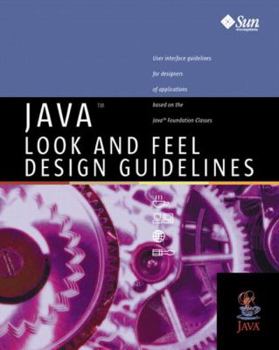Java Look and Feel Design Guidelines
Java Look and Feel Design Guidelines provides essential information for anyone involved in the process of creating cross-platform Java(TM) applications and applets. Offering design guidelines for... This description may be from another edition of this product.
Format:Paperback
Language:English
ISBN:0201615851
ISBN13:9780201615852
Release Date:January 1999
Publisher:Addison Wesley Publishing Company
Length:231 Pages
Weight:1.33 lbs.
Dimensions:0.7" x 7.4" x 9.2"
Customer Reviews
5 ratings
Expert advice for GUI creation in Java
Published by Thriftbooks.com User , 22 years ago
Creating clean, intuitive interfaces is a complex task using any set of tools. It is further complicated by the significant differences between the tools, both in appearance and performance, where a significant difference can be a rather small thing. The Java Swing toolkit and supporting classes differs from others and if it is your platform, then you should take a look at this book. Written by the interface experts at Sun Microsystems, this is as good as it gets. At the meta-level, the guidelines are no different from those in any other language. The best designs are patterns that should be followed independent of the platform and some of the book is devoted to following those "universal" designs. From that perspective, the book is just another description of interfaces. However, the real value is at the specific level, where the reader is taken down to the point where Java differs from other platforms. All of the examples are demonstrated using a combination of point-by-point descriptions with supporting color figures. I teach corporate training courses in Java, including one about designing interfaces and I write my own material for the classes. As I was reading the book, I went back through those lessons and made some alterations based on the guidelines. After following this up with a series of before and after contrast examinations, it was clear that the after was better than the before. I am confident that your experience will be the same.
Just what I needed!
Published by Thriftbooks.com User , 22 years ago
This book fills an important information gap in Java 2 programming. It's the first book I've seen that addresses Java look & feel issues with any depth. I especially appreciated the tips on Java standards and implementation. On my current project, I'm responsible for the user interface design and development, and this book is already heavily dog-eared!
get it online!
Published by Thriftbooks.com User , 22 years ago
One excellent feature of the book is that it and its code samples are available free online from Sun at java.sun.com/products/jlf/This book is very specifically aimed at designers who want to lay out components that mesh visually with Java's Metal, a Swing-based (javax.swing) cross-platform look and feel. As another reviewer pointed out, it's not primarily about designing an interface for usability, but for look and feel. It doesn't completely ignore usability issues, but only covers the basics that are built into the platform. For instance, the book details how many pixels of space to use between buttons and how the text and image on the button should be placed and what it should look like in active/inactive/selected states. Another example is a detailed description of designing icon bitmaps for different color depths, platforms and internationalization. This book's invaluable for the detailed description of the behavior of the Swing. A simple example is the description of selecting items in a JComboBox by (a) clicking the primary mouse button to activate the list and clicking on a selection, or by (b) depressing the primary mouse button, scrolling to the selection, and releasing. This is not a book about Java programming per se, but contains many links to illustrative code examples for the look and feel. But you won't get a detailed description of event dispatching. (To the book's credit, it does examine which events are available per component.) Despite its wordiness, I like Kim Topley's book on JFC for the description of the event model and the components, but I haven't compared Topley's book to anything more recent.
Excellent resource for web developers
Published by Thriftbooks.com User , 24 years ago
Whereas Windows developers usually have a copy of Microsoft's 'Windows Interface Guidelines for Software Design' to turn to for advice on behaviour and usage of Windows elements, such a resource has been sorely lacking for developers of applications for the internet.This book fills the gap admirably.It provides a comprehensive set of guidelines on the use of the various components of an internet application (windows, dialogs, menus, buttons and so on), with detailed descriptions of their appearance and behaviour.As with any set of guidelines, there are individual elements and recommendations with which one could disagree.This is an eminently practical and useful book, and I believe it should be on the bookshelf of every developer of internet applications - whether using Java or another tool.
Great Book!
Published by Thriftbooks.com User , 24 years ago
I reviewed this book when it was being written and I wanted to share my thoughts.- The book's approach is VERY useful and appropriate for the intended audience - Programmers, developers, designers, user interface professionals, graphic designers, technical writers, and managers.- It is a needed book in the Java world. There are no competitors in the Java platform. Similar books are the Microsoft "Windows Interface Guidelines - A guide for Designing Software" for the DOS, OS/2 and Windows platform, and the Apple "Mac OS Human Interface Guidelines" for the Mac platform.- This book fills a void in the Java world. The Windows and Macintosh platforms both have industry guidelines documents that serve as the seminal reference books for developers on each platform.- This book is necessary reading for all Java developers, designers, and interface designers. - I would recommend this book to my many colleagues who are developing Java applets and applications. It is a critical addition to our programming library and list of programming and design books.




